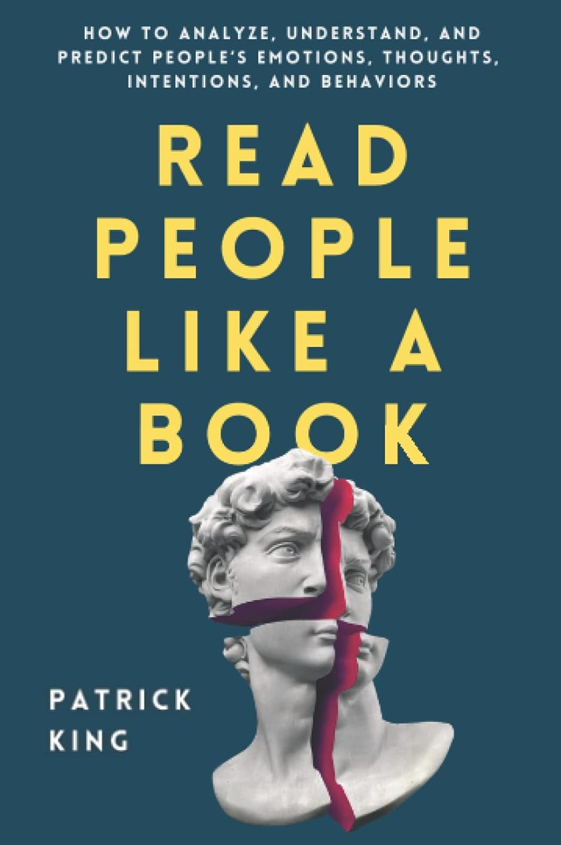Author: Patrick King
Length: ~200 pages
Genre: Psychology / Self-help / Communication
Introduction
Patrick King’s Read People Like a Book is a popular self-help guide designed to equip readers with the tools to better understand and analyze human behavior. King, known for his expertise in social dynamics and interpersonal communication, draws from psychology, behavioral analysis, and real-world experience to offer readers insight into how to interpret nonverbal cues, body language, and conversational patterns. This book claims to help readers improve their emotional intelligence and decode others’ intentions—not through mind-reading, but through observational acuity and logical interpretation.
This review will explore the book’s strengths and weaknesses, highlight its key takeaways, and examine its overall value for readers interested in psychology, self-awareness, and improved interpersonal skills.
Pros
1. Accessible Language and Clear Structure
One of the strongest points of Read People Like a Book is its approachable tone. Patrick King avoids academic jargon and instead opts for everyday language, making complex psychological ideas easier to understand. He structures his ideas logically—starting from foundational concepts such as perception and bias before moving on to specific cues like body language, tone of voice, and microexpressions.
Each chapter focuses on a specific theme, such as detecting deception, understanding emotional states, or the psychology of manipulation. The progression feels intentional and digestible, even for those unfamiliar with behavioral science.
2. Actionable Advice
King provides practical techniques that readers can apply immediately in everyday situations. For instance:
- How to detect incongruence between someone’s words and their body language
- How to read facial expressions for genuine vs. fake emotions
- How to spot signs of nervousness or deception
- How to recognize manipulative behaviors and gaslighting tactics
These strategies are reinforced with real-life examples and scenarios, helping readers visualize how the advice might work in social or professional contexts.
3. Focus on Self-Awareness
Unlike books that focus purely on analyzing others, Read People Like a Book also emphasizes introspection. King repeatedly reminds readers to examine their own biases and assumptions. He points out how perception can be clouded by our expectations, desires, or fears, which is a critical reminder for anyone hoping to assess others more objectively.
This dual focus—understanding others while reflecting on oneself—adds depth to the book and makes it more than just a “guide to reading people.” It’s also about becoming more emotionally and socially intelligent.
4. Broad Application
The skills and concepts in the book can be applied in a variety of contexts—job interviews, relationships, negotiations, customer service, and even parenting. The author doesn’t limit the scope to professional scenarios, which makes the material widely relevant.
Whether you’re a manager trying to assess employee morale, a teacher working to understand student behavior, or simply someone hoping to improve your social interactions, you’ll find useful insights here.
Cons
1. Lack of Academic Rigor
While the book draws on psychological principles, it does not cite peer-reviewed research extensively. Readers looking for a more scientific, evidence-based approach may find the content too simplistic or anecdotal. For example, references to concepts like “microexpressions” or “emotional leakage” are delivered without sufficient grounding in studies or theories by figures such as Paul Ekman or other psychologists.
This doesn’t invalidate the advice, but it does mean that the book is better suited for casual readers rather than students or professionals seeking scholarly material.
2. Repetition and Redundancy
In some places, the book tends to repeat itself. Ideas about congruence between verbal and nonverbal signals, or warnings about the dangers of assuming too much too quickly, recur multiple times. While these are important concepts, their overuse can make the book feel padded or circular in its logic.
A more concise delivery would have increased the book’s impact without diluting its message.
3. Overpromising in the Title
The title—Read People Like a Book—suggests a kind of omniscient ability to decode human behavior. However, the reality is that interpreting people is far more complex and nuanced than a set of checklists or signals. Though the book acknowledges this at times, the overall tone can feel overconfident about what one can truly “know” from body language or speech patterns.
This could mislead readers into thinking that others can be easily or definitively “read,” which is rarely the case in real-life interactions. Human behavior is context-dependent, and this nuance isn’t always sufficiently explored.
4. Limited Cultural Considerations
Nonverbal communication and behavioral cues can vary significantly across cultures, but the book mostly presents its advice from a Western, particularly American, perspective. This lack of cultural sensitivity could lead to misinterpretation in cross-cultural contexts. For example, gestures, eye contact norms, or expressions of emotion differ widely between East Asian, Middle Eastern, European, and African cultures.
A brief chapter or section on cultural variations in behavior would have made the book more globally relevant and responsible.
Key Takeaways
- People are always communicating, even when they’re silent—through posture, tone, pacing, and microexpressions.
- Reading people is not about being psychic, but about being observant and contextually aware.
- Our own cognitive biases often cloud our interpretations; practicing objectivity is key.
- Manipulative behaviors often rely on subtle distortions of truth and can be identified through patterns.
- Emotional intelligence isn’t just internal; it’s also the ability to read others and respond appropriately.
Who Should Read This Book
- Beginners in psychology or personal development who want to better understand interpersonal cues
- Professionals in HR, sales, leadership, or education roles
- Individuals recovering from toxic relationships who want tools to recognize manipulation
- Anyone interested in becoming more socially aware and emotionally intelligent
Final Verdict
Patrick King’s Read People Like a Book is an engaging and user-friendly guide to human behavior. While it lacks academic rigor and sometimes oversimplifies complex psychological processes, it excels at delivering digestible insights and real-world advice. For casual readers, the book offers valuable strategies for observing, interpreting, and understanding others more accurately.
If you’re looking for a practical toolkit to enhance your communication and social awareness—without needing a psychology degree—this book is a worthwhile read. Just remember: people are not actually books, and true understanding requires patience, empathy, and humility.
Rating: ★★★★☆ (4 out of 5)
You can purchase it on Amazon if you like.

